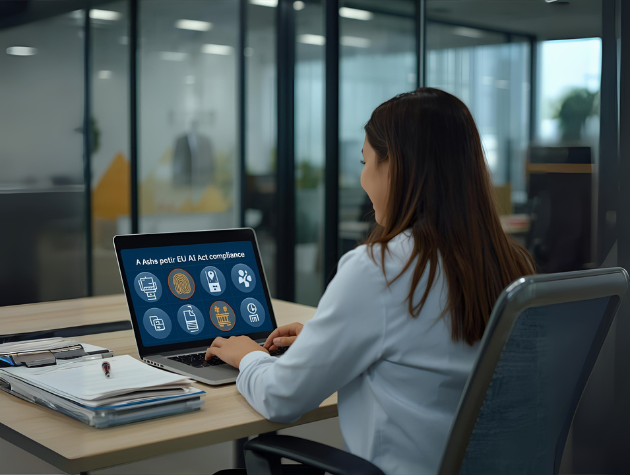AI-generated image of a lawyer reviewing legal documents while colleagues use AI-powered tools in the background. The scene captures both the promise of efficiency and the hidden risks of intellectual property, privacy, and liability challenges in corporate use of AI, underscoring AI risks crucial for in-house lawyers.
Watch the full conversation with Mitch Jackson here:
Is your company’s AI quietly putting you at risk?
Picture this: your marketing team uses an AI tool to generate copy and visuals for a campaign. The launch is seamless until a demand letter arrives. The AI-created work incorporates protected content, exposing the company to an infringement claim. What looked like a shortcut has now become a costly liability. These scenarios represent serious AI risks that in-house lawyers should be prepared to handle.
For in-house lawyers, this isn’t a far-off hypothetical. It’s a daily concern as businesses race to adopt AI. The question isn’t whether your company will use AI it’s whether you’ll help it do so responsibly by assessing the risks AI poses for in-house counsel.
The Double-Edged Sword of AI Adoption: Key AI Risks for In-House Lawyers
As trial lawyer and mediator Mitch Jackson recently noted, “You’re taking a risk by not leveraging AI but you’re also taking a risk by using it without foresight.” Both statements are true. Companies that ignore AI may fall behind, but those who rush in without governance risk regulatory penalties, litigation, or reputational damage.
That’s where in-house counsel must step in not to stop innovation, but to guide it. Recognizing AI-associated risks is an essential aspect for these legal professionals.
AI Risks for In-House Lawyers: IP Ownership in the Age of AI
Intellectual property is the first landmine. Copyright, patent, and trademark laws haven’t disappeared just because an algorithm is involved. Courts have already signaled that “human authorship” is required for copyright protection. That means your company may not own AI-generated code, images, or text even if your employees created them using a tool. This underscores risks AI can present for in-house legal teams.
Equally troubling, the company could be held liable if AI-generated content infringes on someone else’s protected work. For in-house teams, the takeaway is clear: establish internal policies now. Define when and how AI outputs can be used, and clarify ownership expectations across the business. Addressing AI risks is crucial for mitigating legal challenges.
Privacy and Confidentiality Risks of AI for In-House Counsel
Beyond IP, privacy and confidentiality risks are multiplying. Employees may copy sensitive data into AI tools without realizing that the information could be stored, reused, or even made available to other users. That’s a direct threat to trade secret protection. In-house lawyers must understand these AI-related risks.
Regulators are also paying attention. In the Everalbum case, the FTC required not only deletion of improperly obtained data but also the destruction of the algorithms trained on that data. That precedent sometimes called “algorithmic disgorgement” means a single compliance misstep could wipe out years of development, a significant risk for AI deployment managed by in-house teams.
Liability and the Blame Game
Who’s responsible when AI causes harm? The employee? The company? The vendor? Often, it’s all three. Vendors of generative AI tools typically include strong indemnity clauses in their terms of service, leaving businesses on the hook for downstream liability. In-house lawyers need to scrutinize these agreements carefully and educate leadership about the risks and responsibilities.
How In-House Counsel Can Lead with Foresight
The solution isn’t to ban AI. It’s to build a framework for responsible use. That starts with:
- Training employees on what data can and cannot be shared with AI systems
- Drafting clear internal AI use policies tied to existing IP and privacy strategies
- Monitoring litigation and regulatory developments like New York Times v. Microsoft/OpenAI
- Collaborating with leadership to balance innovation with risk management in the context of AI use
In-house lawyers are uniquely positioned to help their companies embrace AI while avoiding costly mistakes. The role isn’t just about saying “no” it’s about shaping how the business says “yes” to AI responsibly. Those informed about AI risks can offer better guidance.
What’s Next for You?
As AI continues to reshape business, the legal function can either play catch-up or lead from the front. By setting guardrails today, you’re not only protecting the company you’re building a legal team that enables innovation with confidence. Recognizing and managing AI risks is integral to this leadership.
This isn’t just about risk mitigation. It’s about positioning yourself and your company for the future. Understanding AI risks for in-house counsel will be pivotal in shaping legal strategies moving forward.
Watch the full conversation here: Notes to My (Legal) Self: Season 7, Episode 6 (ft.Mitch Jackson)
Join the Conversation
At Notes to My (Legal) Self®, we’re dedicated to helping in-house legal professionals develop the skills, insights, and strategies needed to thrive in today’s evolving legal landscape. From leadership development to legal operations optimization and emerging technology, we provide the tools to help you stay ahead. AI risks are an essential component of these discussions.
What’s been your biggest breakthrough moment in your legal career? Let’s talk about it—share your story.



